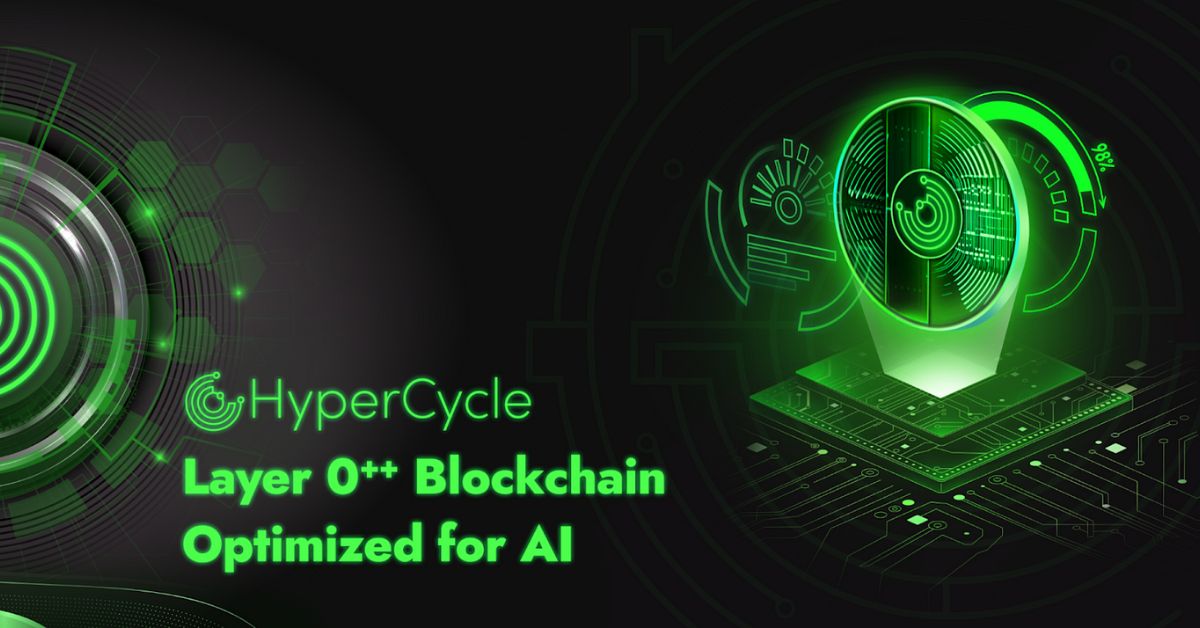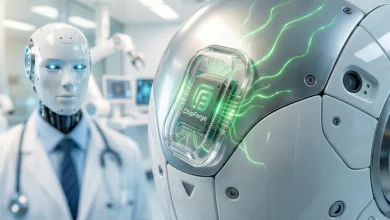
The market for AI technologies is worth around $244 billion in 2025, and while that number seems impressive, the forecast is even more so: it will exceed $800 billion by 2030, according to Statista. In light of this, the Internet of Things (IoT) has transitioned into the Internet of AI Agents (IoAA), a decentralized network that connects artificial intelligence systems. It is emerging as a transformative force in the world of artificial intelligence, but critical concerns related to centralization, security, and scalability remain.
HyperCycle, an open network infrastructure, is a suitable solution for secure and efficient IoAA systems with applications in smart supply chains, healthcare, business, finance, and more. AI agents in warehouses, trucks, ports, and factories can coordinate in real time and handle route optimization, customs clearance, predictive maintenance, and demand forecasting, reducing delays and logistics costs. In healthcare, they can manage patient records, recommend treatments, schedule appointments, and even detect anomalies from wearable data. This will alleviate the administrative burden, speed up diagnosis, and enable more personalized care.
Developers can leverage the decentralized marketplaces developed by HyperCycle to build innovative applications using agents’ collective intelligence. These applications are likely to attract users and enhance revenue. HyperCycle integrates global intelligence to ensure its AI systems continuously improve. Once linked, one AI can monetize expertise by offering services to other AIs.
Centralized systems create a single point of failure
Before these ambitious transformations, AI networks must start operating within a decentralized framework. Each centralized system has a single point of failure and increases vulnerabilities to technical issues or cyberattacks, which can have dire consequences, such as halting operations and inflicting losses.
Many companies rely on centralized AI services like OpenAI API, Azure AI/ML services, and others hosted on centralized cloud infrastructure. Imagine, for a second, if you will, a cyberattack or outage of Microsoft Azure’s data centers impacting GPT-based customer support agents, model training environments, or API rate-limiting systems. Financial companies that use AI for algorithmic trading will miss crucial signals, leading to financial losses. Marketing teams that rely on content generation will face delays, and developers using AI code will see their output plummet. These failures mean tanking stocks due to service unreliability and panicked investors or direct revenue loss for firms that rely on AI automation.
There’s no need to stretch your imagination. In 2023, Azure’s API rate-limiting problems led to project delays and frustrated developers. A developer deployed Azure OpenAI service with a token limit of 1,000 a minute, and his first request used just 223 tokens, but subsequent ones triggered error messages. The reason was that his requests had been too frequent, exceeding the limit for the respective pricing level. He was invited to upgrade his account and received other equally frustrating suggestions.
Apart from intermediaries introducing vulnerabilities and inefficiencies, they’re much more expensive to secure and transmit transactions through than the micro-transactions themselves. Currently, systems charge more than $0.01 per transaction, but AI services often cost fractions of a cent, making micropayments prohibitive and unfeasible.
A decentralized, secure, and scalable framework as a solution
HyperCycle’s decentralization and innate scalability empower firms and developers to unlock AI’s full potential. Among other things, it achieves these through a technology known as “Network Node Factory,” which allows anyone, anywhere, to take part in AI-driven wealth creation. This is mainly due to the nodes’ independence, autonomy, and self-governance. They eliminate third parties, and the decentralized node network on which HyperCycle operates minimizes the risk of a single point of failure and deters attacks on the system. AI agents communicate directly and operate in the AI machine’s network node.
HyperCycle’s nodes scale effortlessly, with the “unlocking” process ensuring demand of any degree is sufficiently met. One HyperCycle node unlocks into two, then four, and so on. A single node can multiply into 1,024 over time, as unlocking can occur up to ten times. The exponential growth makes sure the network can handle higher loads and maintain top performance while accommodating as many agents as needed.
HyperCycle’s clients don’t compromise on security because the platform uses cryptographic proofs to protect transactions and interactions between AI agents. Its ledgerless architecture offers superior performance to traditional ledger-based systems and reduces vulnerabilities. By using cryptographic proofs instead of a distributed ledger, it mitigates vulnerabilities such as double-spending (when an entity spends the same cryptocurrency twice by exploiting the delay in transaction confirmation on the blockchain) and 51% attacks (an entity controls more than half of a blockchain’s mining hash rate, allowing it to censor transactions, rewrite parts of the blockchain, etc.)
Last but not least, HyperCycle agents continuously learn about new threats and adapt to them more easily. They can communicate and collaborate despite differences in their source or design.
New and accessible opportunities to monetize the Internet of AI Agents
The IoAA presents numerous opportunities for monetization, but they remain theoretical in the absence of secure and decentralized platforms. HyperCycle capitalizes on this emerging ecosystem through AI service marketplaces, AI-driven solutions, infrastructure and support services, and reduced developer costs, among others.
Marketplaces are decentralized platforms where AI agents can offer translation, data analysis, image recognition, and other services. In business, decentralized AI agents can autonomously handle customer interactions across platforms, learning and adapting to each user’s preferences. This enables real-time personalization, faster response times, and service continuity even if one node fails.
In transport, they can optimize route planning, traffic management, and logistics, improving efficiency and reducing costs. Decentralized AI agents can independently coordinate with vehicles, traffic systems, and local data sources to optimize routes in real-time without needing a central control hub. This allows for faster, more adaptive rerouting in response to traffic, weather, or accidents, improving efficiency and reducing delays.
AI agents can also collaborate to provide real-time financial analysis, risk assessment, and investment recommendations, enhancing the accuracy and speed of financial decisions. Decentralized AI agents can analyze market data locally and collaborate to detect trends and anomalies without the risk of centralization-induced bottlenecks. This enables faster financial insights, even at times of high volatility and perhaps especially then.
HyperCycle users can develop and sell AI-driven solutions based on the network’s collective intelligence. For example, an AI agent can combine insights from various sources to provide companies with predictive analytics.
One infrastructure and support service that facilitates IoAA operation involves providing secure transaction processing and communication channels.
Developers can access AI services on decentralized marketplaces without incurring additional costs. While this doesn’t automatically mean higher profitability, at least there is no risk of fees eating into profit.
HyperCycle Is The Gateway To A Decentralized Future
HyperCycle’s authentic peer-to-peer network enhances users’ AI capabilities, offering an innovative and surprisingly affordable way to tackle complexities. Each activated Node Factory expands the network’s reach and unlocks advanced computational layers.
The nodes within the HyperCycle ecosystem facilitate the generation of short- as well as long-term wealth, like a business whose value increases over time. Optimally managed nodes accumulate worth and offer a sustainable route to financial growth. Beyond a viable solution, HyperCycle is a gateway to a safer, decentralized, and more intelligent future. Enhanced security, scalable intelligence, peer-to-peer collaboration, and boundless autonomy help individuals and organizations build sustainable value.
Trust with CoinPedia:
CoinPedia has been delivering accurate and timely cryptocurrency and blockchain updates since 2017. All content is created by our expert panel of analysts and journalists, following strict Editorial Guidelines based on E-E-A-T (Experience, Expertise, Authoritativeness, Trustworthiness). Every article is fact-checked against reputable sources to ensure accuracy, transparency, and reliability. Our review policy guarantees unbiased evaluations when recommending exchanges, platforms, or tools. We strive to provide timely updates about everything crypto & blockchain, right from startups to industry majors.
Investment Disclaimer:
All opinions and insights shared represent the author's own views on current market conditions. Please do your own research before making investment decisions. Neither the writer nor the publication assumes responsibility for your financial choices.
Sponsored and Advertisements:
Sponsored content and affiliate links may appear on our site. Advertisements are marked clearly, and our editorial content remains entirely independent from our ad partners.








